Chinese Name: 芙蓉镇 Pronunciation: fú rónɡ zhèn
English Name: Furong Town or Hibiscus Town
Opening Hours: 8:00-18:00
Suggested Visiting Hours: 3 Hours
Buiding Time: More than 2000 years
Building Function: It was built for residence.
Address: Yongshun Couty, Xiangxi Tujia and Miao Autonomous Prefecture, Hunan Province
Admission Ticket Fare: 100 Yuan(Please notice that the ticket should be booked 1 day in advance.)
1.Children under 1.3 meters are free of charge.
2.Senior citizens over 70 (with an ID card or passport) are free of charge.

Located in Yongshun County, Xiangxi Tujia and Miao Autonomous Prefecture, Furong Town is an ancient town with a long history of more than 2000 years. Furong Town, Liye Town in Longshan County, Pushi Town in Luxi County, and Chadong Town in Huayuan County are known as “Four Famous Towns in Xiangxi”. The town is a place where the Miao ethnic minority, and the Tujia ethnic minority, and Han people live, among which the Tujia Minority account for 80% of the total population. It is a natural beauty, cultural and historical heritage, and folk customs that make Furong Town a popular tourist attraction.
Furong Town is on the north riverside of Youshui River. Travelers can easily arrive in Sichuan and Guizhou provinces through its convenient waterways from here. Furong Town was the business port in Yongshun in ancient times. It has a reputation as The “Great Town of Youyang” as well as “Little Nanjing.
Furong Town was a low-profile tourist spot and not attractive to outsiders before because of its rural location. In recent years, however, Furong Town has become a popular destination for those who would like to get away from the hustle and bustle of the city on holiday, which benefits from the wide use of social media and convenient transportation.
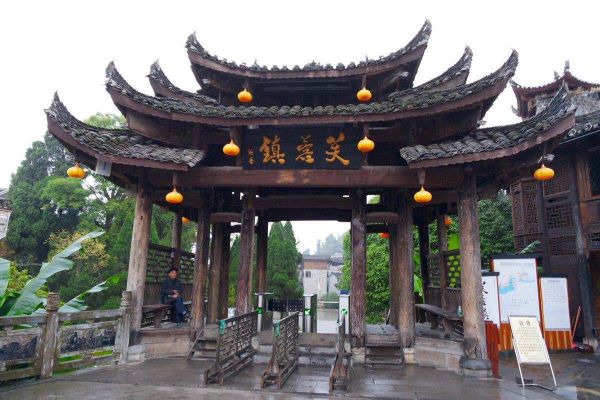
Thousands of tourists flood into Furong Town, which is a good summer spot especially in the summer holidays. The famous scenic spots include Five Stone Street, Waterfall of Furong Town, Palace of Tusi King, Xizhou Copper Pillar, and the night view of Furong Town. In addition, there are many other attractions deserving exploration.
Furong Town has both a beautiful natural landscape and rich historical and cultural human heritage. The buildings of Furong Town display the architectural style of the Ming and Qing Dynasties. The unique wooden house, named Diaojiaolou, is well-known at home and abroad, which was built on stilts to prevent people from spring floods.
The Tujia Minority here has been settled for thousands of years. If one wants to experience the Tujia’s lifestyle, one must visit a Tujia village in Furong Town. Tujia women do not wear many cosmetics. They love dressing in kinds of colorful garments. Thus, red plays an important role in their daily life. They also like to wear silver, gold, and jade ornaments.
There are many interesting and meaningful festivals of the Tujia Minority every year. According to the different contents of festivals, they can be divided into sacrifice festivals, commemoration festivals, celebration festivals, social entertainment festivals and festivals for celebrating a good harvest. Many traditional customs are well preserved. Therefore, travelers can experience authentic Tujia’s folk customs at Furong Town.
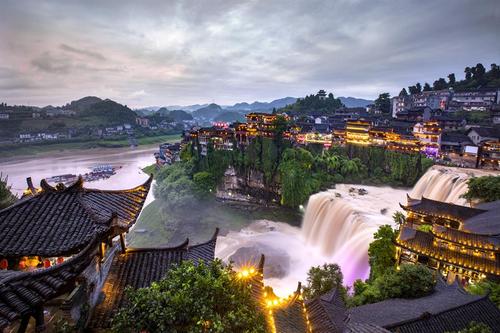
The staple food of the Tujia people is rice. Moreover, people also take a liking for corn, mung, pea, and sweet potato. The dishes of Tujia are characterized by sourness and spiciness. If you don’t want too much chili and pickle when you are in a Tujia’s restaurant, you’d better tell the waiter or waitress when you making an order. The pickle is a necessary flavor in Tujia’s dishes, which is almost everyone’s favorite there. It seems that people can not have a meal without it. What’s more, Tujia people are also keen on bean products, such as bean curd, lobster sauce, and preserved bean curd.
Ginger sugar is a popular snack in Furong Town. The ginger sugar is made from brown sugar, ginger, and water. Thus, it tastes both sweetness from sugar and spiciness from the ginger. People in Furong Town are friendly, hospitable, and warm-hearted. They like interacting with visitors in a variety of traditional festivals and recreational activities. Furong Town is a place worthy of visiting. The ancient town is full of cultural atmosphere and has not been over-commercialized. One can enjoy the beautiful and attractive scenery here.
Ancient towns, such as Phoenix Town, Wuzhen, Zhouzhuang Water Town, and Furong Town, are special treasures in China. Some valuable things which are lost in big cities can be found in the ancient towns, because the tradition of them is mostly kept. Most of the ancient towns are far away from the hustle and bustle of the big cities and close to nature. They are the balanced zone between city and country, and also the equilibrium point of modern people’s life and soul.
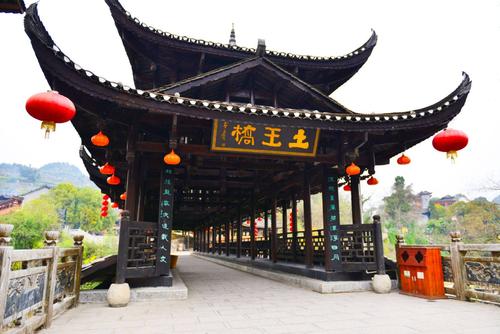
Furong Town, whose former name is Wang Cun and belonged to Youyang county in the Western Han Dynasty.
In 910, the King of Chu Kingdom, Mayin, sent a prefectural governor to Xizhou, and stationed at Wang Village.
In 1729, the Emperor Yongzheng of Qing Dynasty set up Yongshun County.
In 1986, the Chinese famous director Xiejin shot the film Hibiscus Town in Furong Town. With the release of the movie, this town became a popular tourist destination. It is the screening of Hibiscus Town that has promoted the development of the local tourism industry.
In 2007, Wang Village was renamed Furong Town.
The list of The First Batch of Ten Characteristic Town in Hunan Province was released during the opening ceremony of the Hunan International Cultural Tourism Festival on September 22nd, 2019. It is undoubted that Furong Town was listed as the national town of folk customs.
The great waterfalls, stilted buildings, ancient stone streets, and beautiful scenery display a landscape of harmony between nature and humanity.
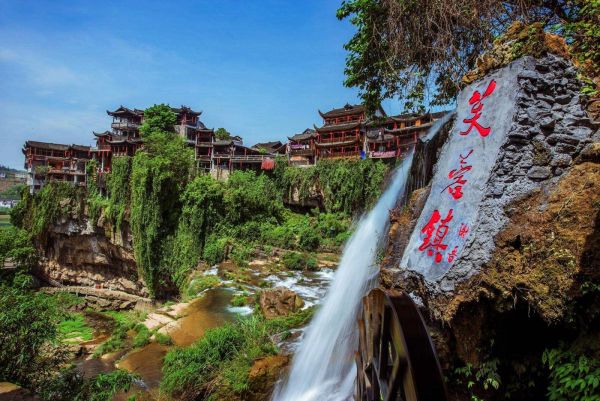
In 940, King Ma Xifan of Chu and former prefectural governor Peng Shichou reached an agreement after years of battle that they would not infringe on each other’s territory. Then, they built a copper pillar weighing 250kg to be the proof. The process of the battle and terms of negotiation were engraved on the pillar. The Tujia people regard the copper pillar as a holy item. It is an important document to study the history of the Tujia Minority. In 1961, it was listed as the national key protected cultural relic by the State of Council.
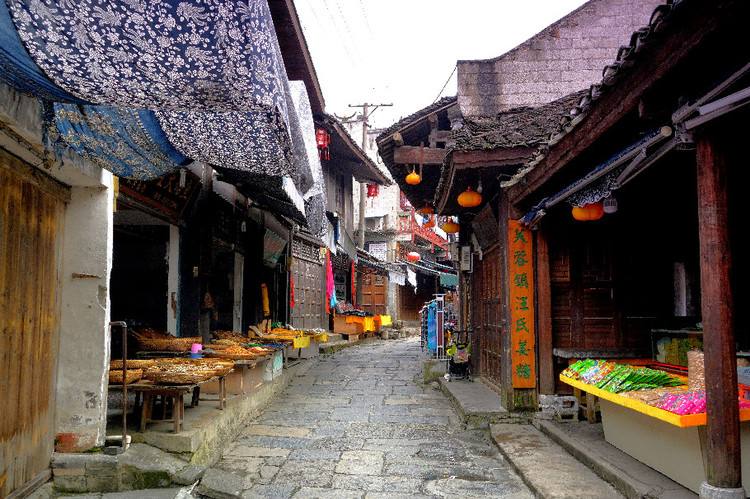
There is a well-preserved stone street in Furong Town. The ancient stone street has been lying there quietly for hundreds of years, seeing ups and downs of times. Lined with shops and stilted buildings, it stretches along the road, bringing travelers to the dock of Youshui River.
The memory of ancient times remains unchanged here and much previous historical and cultural heritages are well preserved. One can see traditional Tujia garments clothes shop, traditional and authentic special snacks, local style handicrafts, and enjoy traditional Tujia dishes in the Wuli Street. The architectural style of the Tujia Minority is well displayed. The waterfall and Youshui River camp are visible from the left side of the dock.

Furong Town surrounded by water on three sides has a picturesque landscape of the rushing waterfall. The waterfall is the premier natural beauty in Furong Town and anyone who visits Furong Town must visit the waterfall. It is the largest waterfall in the Xiangxi area, pouring down from the cliff to Youshui River. The grand spectacle earned Furong Town a new title - the Millennium Ancient Town Hanging on the Waterfall. It is a wonderland that tourists will definitely enjoy.
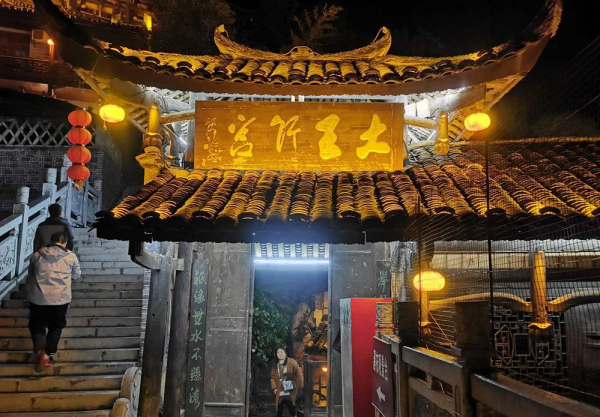
The Tusi Palace next to Furong Town Waterfall is also a highlight where was summer resort was built by Tusi King. Built beside the cliff, the Palace has a unique Tujia ethnic style, with the waterfall running in front of it. During the reign of King Tusi, it was barracked where soldiers lived.
In 910, Peng Shichou created the Tusi Dynasty, whose capital was Wang Village. At the same time, the Youyang Palace was built, a summer resort where kings got away from hot weather.
There are poems and paintings composed by Chinese famous poet Tang Bohu and writer Shen Congwen, a tea house where the famous actress Liu Xiaoqing tasting tea while visiting the waterfall, and many shooting locations of TV dramas.
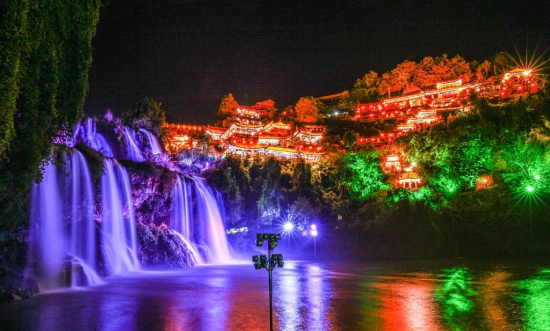
The most beautiful and fascinating side of Furong Town lies in its night. Without the noise of Phoenix Town, the nightscape of Furong Town is peaceful and charming. On special days, Furong Town attracts a large number of tourists. The town tends to welcome its tourist peak as summer vacation comes. The red lanterns hang on stilted buildings, leaving tourists a feeling of placing themselves in ancient times.
a. From Zhangjiajie to Furong Town
Take a direct bus from Zhangjiajie Bus Station (next to the railway station) to Furong Town, which takes about 1.5 hours and costs 25 yuan per person.
b. From Phoenix Town to Furong Town
Take bus to Zhangjiajie from Phoenix Ancient Town Bus Station and get off at Furong Town Station, which takes about 2.5-3 hours.
